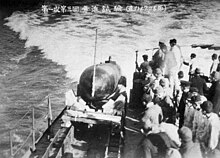Kaiten
In recognition of the unfavorable progress of the war, towards the end of 1943 the Japanese high command considered suggestions for various suicide craft.
Once the target was acquired and the host submarine was within range, the pilot was briefed, the Kaiten's starting air bottles were charged, and the cockpit was ventilated.
In later models the 5.5 L (9.7 imp pt) Tetrachloromethane starting air bottle is located in the cockpit and a further smaller trimming tank is supplied for use at initial launch.
The engine section is slotted in above the aft trim tank with the joint protected by a sheet metal cowl.
In late 1944, Type 2 prototypes were tested in dry-dock and in controlled submerged conditions; however, they never met a standard satisfactory for open water running.
The complete operation of the engine had to be simple for a pilot who was already under immense stress, so it was designed to be controlled by a single lever.
In initial tests, water pressure caused deformation and seizing of the engine; although strengthening was added, the problem was never fully resolved.
The first uncrewed test runs of the Type 4 at cruising speed were made in early 1945, and it was noted that oxygen efficiency was very low.
The same problem occurred in the first test run with a pilot, with sensor readings indicating a large percentage of unburned oxygen in the exhaust gasses.
The weapon made little progress in development and never exceeded a speed of 40 km/h in open sea trials; this combined with untraceable leaks in the engine and the consequent inefficiency of the propulsion system led to this design being filed as a failure and its eventual abandonment.
The forward section of the weapon contains the warhead and the manual electric fuze, but no contact detonator unlike other kaiten types.
The midsection contains the first set of Type 92 batteries as well as a steering air bottle strapped to the underneath of the weapon.
The Type 10 was designed and intended as a coastal defense weapon to counter the expected invasion of the Japanese mainland by Allied troops.
On 16 July 1945 the Imperial Japanese Naval command ordered the construction of over 500 Type 10s to be stationed and readied for launch from several existing and new kaiten bases.
[21] When compared with the Type 93 torpedo which was surface-vessel–launched, Kaiten had the obvious advantages of having a pilot to guide the weapon, and of being launched from a submerged submarine.
Reasons given for this discrepancy are the fact that the submarine launching the Kaiten could only estimate success by listening for the detonation of their weapons, and also that the size of the explosion after the attack on USS Mississinewa gave the impression of a much larger number of ships sunk.
In total 106 Kaiten pilots lost their lives (including 15 killed in training accidents and two suicides after the war).
In addition to the pilots, 846 men died when eight Japanese submarines carrying Kaiten were sunk, and 156 maintenance and support personnel were also killed.
[26] The Kongō group (金剛隊) of Kaiten operation was undertaken on 9 January 1945 against the U.S. anchorage at Hollandia, Ulithi, Manus, Kossol Roads and Apra Harbor.
I-56 failed to even reach the launching areas for her Kaitens (Manus) and returned home without firing a single shot.
I-44 was sighted and hunted for over two days underwater; crew compartment carbon dioxide saturation reached 6% before she managed to escape.
I-368 was detected and attacked by a Grumman TBF Avenger on approaching Iwo Jima on 26 February and was sunk by Mark 24 Mines with the loss of all 85 hands.
[26][29] The Shimbu group (神武隊) was originally intended to supplement the previous attacks on Iwo Jima and launched on 1 March 1945.
I-36 sighted a lone oil tanker on 22 June and opened an attack with her Kaiten, which both failed, and four conventional torpedoes, which exploded early damaging USS Endymion, a landing craft repair ship.
Further ships later arrived to hunt I-36, but she managed to escape with only a minor leak in the forward torpedo room and a damaged rudder.
On 27 June, a patrolling Lockheed Ventura sighted I-165 and dropped three Mark 47 depth charges which sank her with her crew of 106.
Five days later a patrolling Grumman TBF Avenger detected her and launched a volley of rocket fire, following up with a Mark 24 mine as the boat dived, the explosion of which was felt by the crew of USS Oliver Mitchell 30 km (16 nmi) away.
A day later, I-58 sighted USS Indianapolis and the commander, Mochitsura Hashimoto ordered two Kaiten prepared for attack.
Once in firing range the commander realised it would be a waste of a Kaiten to attack such an easy target, and instead launched a spread of six Type 95 torpedoes, three of which hit, causing the cruiser to sink rapidly.
The Shinshū group (神州隊) consisting solely of I-159, sailed on 16 August 1945 to attack Soviet convoys in the Sea of Japan.











